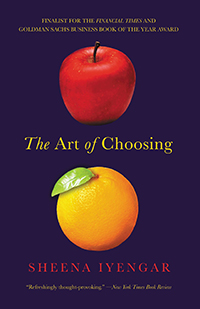We may think we know our own minds, but the forces that influence our choices are many, varied, and often surprising. Most of those forces affect us without our knowledge, and they do not necessarily operate in our best interests. How can we minimize the influence of such powerful factors, including bias and culture? Is it possible to re-train our intuition? How do we balance the competing forces of gut and reason to make better decisions?

Columbia Business School professor Sheena Iyengar, one of the world’s leading scholars on the subject of choice, answers these questions and raises many more in The Art of Choosing. Her book explores the practice of choice across cultures, examines the role of choice in motivation and performance, and presents stunning revelations about how and why we choose, and how we can choose better.
Why write a book about choosing? Iyengar explains, “I was really trying to give people a more holistic perspective on choice and the role it plays in our lives. In many ways, the book is about the culture of choice: what does choice mean to us, how does it affect us, and what are things to think about as you go about doing this thing called choosing.”
Imagination as a form of choice
For Iyengar, choosing is much more than the practice of selection. “I think there are two basic exercises that we as humans engage in. The first is the picking and finding. Being simplistic, that’s the search for information, finding your options, compare and contrast—that’s the whole picking and finding exercise. And a lot of research shows the ways in which we get picking and finding wrong,” she says. “And then there is the imagination.”
Iyengar explains, “We often think that the act of choosing is just picking—which one of these soda pops do I want, etc. But that’s not really where the real power of choice comes from.” She says, “The real power of choice comes from understanding what your needs are, and creating the meaningful option.”
“Ultimately we as humans are unique in that we are able to manifest what we imagine in the kinds of choices that we create and make. “ She says, “There isn’t a single thing that was made in your world that didn’t come out of somebody’s imagination. Whatever it is you eat or drink or wear, everything—unless it’s something produced by nature—everything started off by somebody imagining it and figuring out how to make it into reality, and that’s a very human endeavor.”
In describing one example of that act of creation, Iyengar considers one of the earliest choices made by a start-up. “When you start an organization, the decision-making process you create will, in many ways, determine the culture.”
This first choice about how decisions are made evolves like this: “Decisions are going to be made by everybody voting, or else by having a discussion followed by the leader making a decision. So that decision-making structure you put in place right up front creates the dominant culture. You reinforce that culture or make it more nuanced by who you include in that [decision-making] group. Will you make it a group of individuals who share a very similar perspective, or will you make it a group of individuals who have very different perspectives?”
She says, “I’ve simplified the idea by talking about a start-up with five people, but just think about how the impact of those choices would expand out, to a larger organization or to a country. It gets more and more complicated but at its base, that’s what’s going on.”

Choice in a global organization
One anecdote from The Art of Choosing tells the story of a large business that tested the idea of changing how a production plant operates, moving from an assembly-line structure to a more self-directed, team-based structure. In the first plant, the mostly Anglo employees loved being able to make choices; they were highly motivated and productive under the new structure. When the company tried to implement the team-based system at a second plant which had a lot of Cambodian and Laotian immigrant employees, the results were dismal.
In this scenario, the company did not understand the cultural differences related to choice. Where the Anglo-American employees found being encouraged to make their own choices empowering, “the Asian employees at the second plant wondered why their manager wasn’t doing the job of managing.”
How do organizational leaders address different cultures when it comes to choice? Iyengar says, “When you have a global organization, you will have people with very different perspectives, and essentially your job as a leader is to surface that. Ideally, if you are a good leader you learn everybody’s assumptions and you figure out how to bring people together in a way that does not conflict with those assumptions.”
One of Iyengar’s favorite examples of strong cultural leadership is Mahatma Ghandi and the salt march, defying the British Salt Acts to ultimately fight for India’s independence. “He had a situation where there was no such thing as India, this was just an illusion; there was no such thing as Indian people; this was also an illusion. People were divided by ethnicity, by language, by caste, by religion, and they were all broken up into all kinds of little kingdoms. So suddenly asking these people to come together into one united group was a huge undertaking. And he was brilliant in that he identified salt, because no matter who you are, rich or poor, low caste, high caste, Muslim or Hindu, you’re all eating salt.”
She says, “That was his genius—he found something everybody cared about. For the first time in Indian history you had people marching together that were from all these different groups. That’s an example of being a culturally intelligent leader.”
Gut Versus Reason

As we make choices, two systems come into play: the automatic system, commonly thought of as our gut reaction, and the reflective system, or reason. Iyengar explains the difference. “If I were to ask you, ‘do you think that cake is tasty?’ you can’t reason your way to that one. Your gut is the only one that can answer the question: do you want it or not? The problem with your gut is that you know what you want right now, not what you want in five minutes, or ten minutes, or tomorrow morning when you’re wondering why you did that.” On the other hand, she says, “Reasoned analysis only tells you what you should want, not what you will want. That’s the conflict. Gut tells you what you want right now, and reasoned analysis tells you what you should want.”
She says, “The trick is resolving that conflict to figure out what it is that you will want.”
Several experiments in The Art of Choosing look at the consequences for different individuals who follow either their gut or their reason in making choices, and Iyengar invites readers to consider the benefits of each. However, with regard to resolving the conflict between following gut or reason Iyengar says, “I don’t think a Nobel prize winner could truly resolve that debate.”
What’s the right answer?
The stakes of choosing can be high. Iyengar says, “All the career crises we have are a matter of mis-predicting what we would have wanted. Our preferences are much more malleable than we think they will be; that’s why you fall out of love, and that’s why you start hating your job.”
While there is no simple solution to making better decisions, Iyengar recommends honest self-reflection. “You have to be an observer of yourself,” she says. “You should be keeping track of how good you felt having made this choice or that choice.” Referring to the human penchant for rationalizing past decisions, she says, “You are more stable than you realize; it’s your memory that’s unreliable.”
Iyengar’s second recommendation is to learn from others. “You can look at other people who made the same choice and ask yourself whether you think they’re happy. Chances are, you’re not that dissimilar. So whatever trials and tribulations they’re having, those are what you might have.”
The consequences of choosing can be significant and far-reaching, and the pressure to make the right choice is often overwhelming. Iyengar offers this consolation: “If both your gut and reason are telling you that you should do it, you should just do it. Even if you’re wrong, you won’t regret it.”
Highlights from The Art of Choosing
Something as simple as numerical order can influence our most important choices, as evidenced by the analysis of polling data that shows candidates listed first have a statistically meaningful advantage.
There is such a thing as too many choices, as demonstrated by Iyengar’s famous jam study which shows how fewer options increase the probability that a person will actually choose.
Studies show how perceived attractiveness correlates to an increased likelihood of being hired, receiving higher compensation, and even winning elections, demonstrating how unconscious bias is at play even in carefully considered decisions.
Our perception of choice has cultural underpinnings, for example many people from formerly communist countries in Eastern Europe see several varieties of soda not as a wide selection, but one choice: soda.
Excerpt from The Art of Choosing

In 1998, I persuaded John Reed, inventor of the ATM and CEO of Citicorp at that time, to allow me to examine how people from different cultural backgrounds perceived their work environment, and how this in turn related to their performance and satisfaction with their jobs. Citicorp was already a prominent global bank at the time, with operations spread out over 93 countries on every continent except Antarctica. With Reed’s support, a fleet of research assistants and I conducted a survey with more than 2,000 Citicorp bank tellers and sales representatives in Argentina, Australia, Brazil, Mexico, the Philippines, Singapore, Taiwan, and the United States. Since we also wanted our survey to reflect the high level of diversity within the United States, we went to banks in New York, Chicago, and Los Angeles, where we enlisted a range of participants from different demographics and ethnic backgrounds, including Anglo Americans, Hispanic Americans, African Americans, and Asian Americans.
We first asked employees to rate on a scale of 1 (“not at all”) to 9 (“very much”) how much choice they had in their jobs, both in specific areas like “the way in which I resolve problems at work” or “when to take vacations” and, in general, “the overall amount of freedom I have to make decisions entirely on my own during a typical day at the bank.” Their perceptions of choice were also measured by the extent to which they agreed with the statement “At work, my supervisor makes the majority of the decisions about what I do.” One would expect the employees’ answers to be quite similar; they were, after all, doing the same job. Take the bank tellers, for example: while their duties aren’t as structured as an assembly-line worker’s, they are usually confined to specific tasks such as cashing checks, accepting deposits and loan payments, and processing withdrawals. Because Citicorp strove to keep its operating practices standardized both domestically and internationally, bank employees in all the various branches followed routines and incentives that were essentially the same.
When the results came in, however, they clearly revealed that the ethnicity of the employees (closely linked here to their cultural background) significantly affected the degree of choice they felt was available. Employees in Asia, along with the Asian Americans, were less likely than Anglo American, Hispanic American, or African American employees to think of their day-to-day activities at work in terms of choice, and Latin Americans’ perceptions of choice fell in between these two groups. The less personal choice they thought they had, the higher the level of supervisor control over their actions they perceived. Even those working at the same bank and for the same manager—who reported giving the same levels of choice to all the employees—perceived different degrees of choice available to them, depending on their culture.
Next, we questioned employees about their personal levels of motivation, how fair they thought their work environments were, how satisfied they were with their jobs, and how happy they were overall. We also asked their managers to rate the employees’ current and overall performance at the company. It turned out that for all the American employees except Asian Americans, the more choice they thought they had, the higher they scored on all measures of motivation, satisfaction, and performance. Conversely, the more they felt their jobs were dictated by their managers, the worse they did on all of these measures. In contrast, Asian participants, whether from Asia or the United States, scored higher when they thought their day-to-day tasks were determined primarily by their managers, while greater personal choice had no effect in some areas and even a moderately negative one in others. Latin American employees once again fell somewhere in the middle, slightly benefiting from both greater personal choice and greater control by their managers.
What’s interesting about these results is not only that people have different ideas, based on cultural background, about what constitutes “choice,” but also that they see more of whatever choice condition they prefer. On average, the employees who benefited from greater personal choice saw themselves as having more of it, while those who preferred choice to be in the hands of others also saw this to be the case. Policy changes that make the presence or absence of choice more explicit could have remarkably different consequences for employees from different cultures, as seen in the case of Sealed Air and even in the students who played Space Quest. When left to their own devices, though, people are likely to perceive choice at the level that is optimal for them.
But this isn’t the end of the story. The effects of culture go beyond individuals’ own perceptions of choice and their desire to choose. They shape the way people actually choose (when they do choose), which in turn impacts society as a whole. Let’s just consider the office environment for the moment, whether at Citibank or at any other multinational corporation. The American narrative of the workplace doesn’t just say that more choice is better; it says more choice is better because more choice creates more opportunity to demonstrate competence. The path to success lies in distinguishing oneself from others, and being micromanaged by one’s boss can be stifling both personally and professionally. The Asian narrative, on the other hand, focuses on the benefits to the organization as a whole, which may include leaving choices to the people most qualified to make them: those who are wiser, more experienced, or higher in rank. Though both approaches have benefits, they also have drawbacks: the first can encourage selfishness, while the second can lead to stagnation. This is why companies like Citicorp spend considerable effort on creating a unified corporate culture that tries to capture the best of both worlds from the outset, and they’re still never completely successful. Now, consider the world outside the workplace. How do these differing perceptions of choice and, by extension, control affect how we envision that world at its most ideal?
Thank you to Grand Central Publishing.
Receive AESC's Executive Talent Monthly - Insights for the C-Suite
